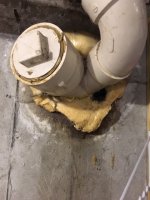bk82388
New Member
Hi everyone, had a quick question in regards to sealing the waste pipe that exits my houses foundation to go out to the septic tank. Currently exits through the foundation wall and it was spray foamed around it to seal it. Not sure if that is the preferred method or not, but unfortunately a mouse or some other critter has taken the time to make a channel through the foam which allowed quite a bit of water into the basement last storm.
Should i just take a can of great stuff to the hole to fill what the critter did, or is there a better more preferred method for sealing this. I put a picture below so you all could see what I was walking about.
Thanks for the help!
Should i just take a can of great stuff to the hole to fill what the critter did, or is there a better more preferred method for sealing this. I put a picture below so you all could see what I was walking about.
Thanks for the help!

